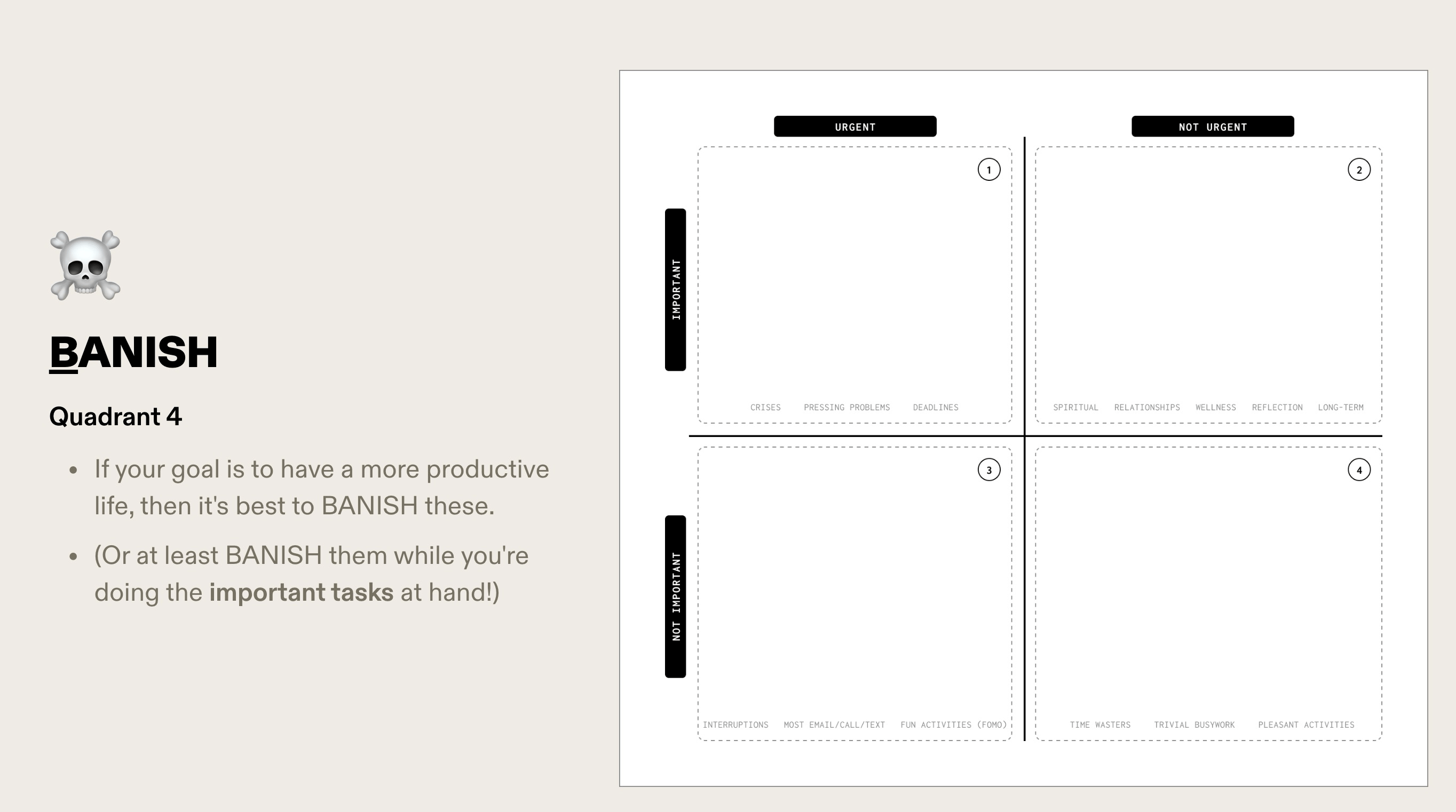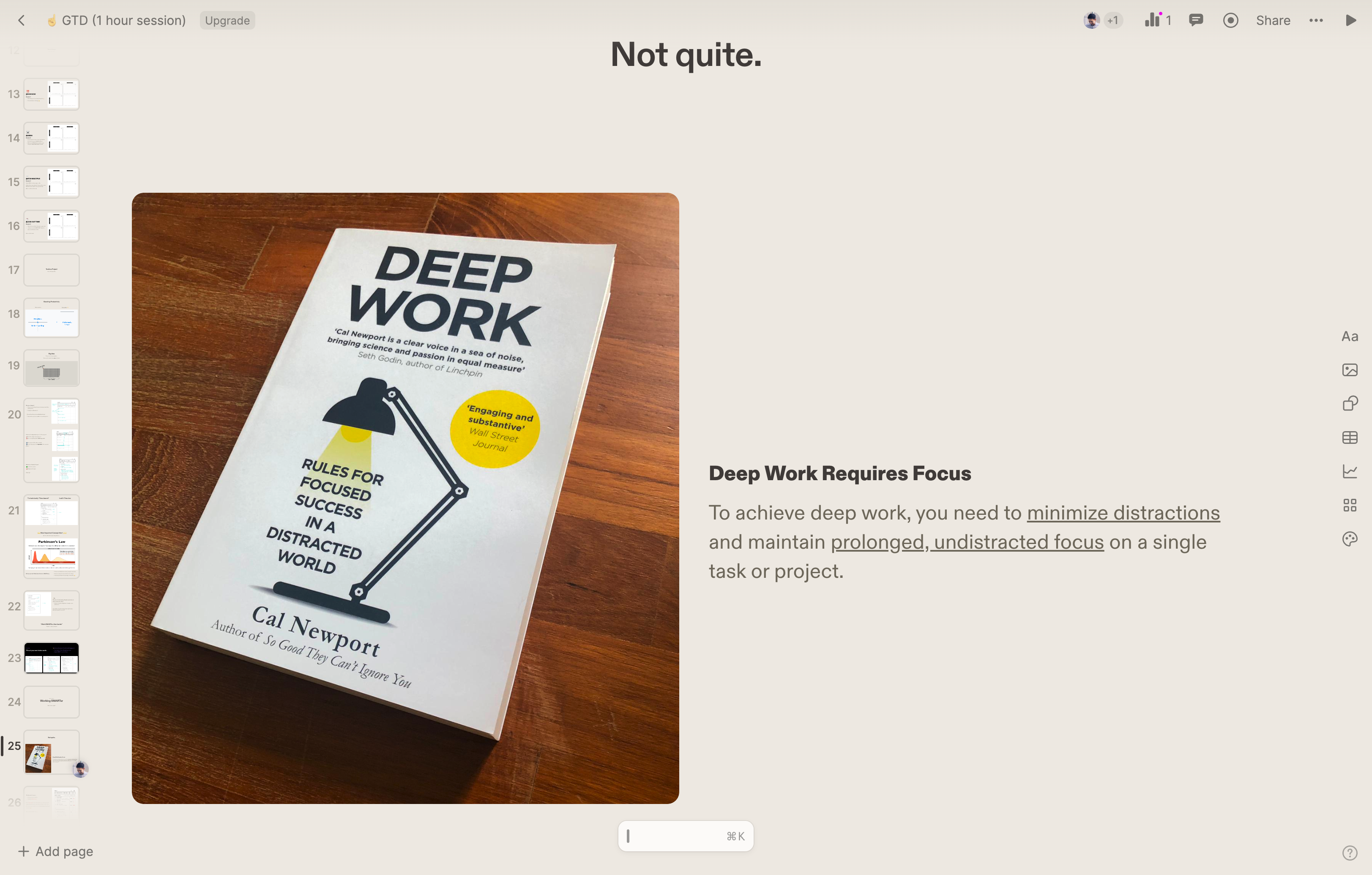The One-Hour Version of Getting Things Done
Learn the essentials of productivity in just one hour. Discover how to work smarter and harder using the Eisenhower matrix and other effective strategies.
By Abe Yang
In this guide, we'll learn how to effectively manage tasks and projects using a streamlined version of the Getting Things Done (GTD) methodology. This one-hour session is designed to help you prioritize and take actionable steps towards completing your tasks. We'll start by understanding the difference between urgent and important tasks using the Eisenhower matrix. Then, we'll develop a game plan for each quadrant, ensuring you focus on what truly matters. By the end of this guide, you'll have practical strategies to work smarter and harder, maximizing your productivity.
1
This is the one-hour version of getting things done.

2
A quick introduction of myself and my peer class.

3
Different ways to get things done include using apps and similar tools. Here's a quick introduction to how I developed this system.

4
Many people have heard the phrase "work smarter, not harder."

5
The model for this class is to work smarter, then harder.

6
And that's the mantra. It's a two-step process: work smarter by prioritizing and understanding what's going on in your life and various projects.

7
Then, work harder by taking actionable steps and putting in the effort to complete them.

8
We will begin at a high level, starting with the basics of prioritizing your life.

9
We will begin with the Eisenhower matrix to separate what is urgent from what is important. Then, we will apply a game plan to each of the quadrants.

10
First, we'll start with a pop quiz. What's the difference between urgent and important? Urgency is something you feel, whereas importance is something you know or have to think about.

11
I have a handout for them to fill out their own Eisenhower matrix. Each one will include prompts to help guide them.

12
Once that is done, I will give them a few minutes to discuss with a neighbor or, if they are at tables, to talk about what they filled out or if there is anything surprising from their Eisenhower matrix.

13
The next steps are called the Four Bs.

14
For quadrant one, they are already doing this. They need to begin now. One thing to note is that this is the procrastinator's strategy. They wait until everything becomes urgent, which might not serve them well in college. As a postgrad, and especially if they plan to become a father or a ministry lead, that strategy probably will not work.

15
Skipping to quadrant four, these are the things you need to banish. They are neither urgent nor important. Listing them helps you recognize that, especially when tackling something important, you must eliminate these distractions.

16
Quadrant three involves batching multiple tasks. It's about managing various interruptions in life. I help them distinguish different types of messages. For example, if your wife is pregnant and about to have a baby, that's not a quadrant three task; it's a quadrant one task.

17
Finally, for quadrant two, block out dedicated time.

18
This part is often neglected because it's important but not urgent. We need a strategy for this, and right now, it's about blocking out time. That's the high level. Now, let's tackle a project.

19
We are going to list and prioritize. We are now in the second half of this process, which involves taking actual steps. After working smart, you need to work hard.

20
The big idea is that there are many things on your plate. Instead of focusing on everything, concentrate on what's ahead and choose the right thing to focus on.

21
Here we go. We need to find a project from your Eisenhower matrix and write down tasks. For example, message prep first draft.

22
From there, identify the important aspects of the project and cross out anything that's not important.
If needed, they can refer back to the Eisenhower matrix for guidance. Here, the goal is to weed out unimportant tasks. For example, in a video project, one brother overly focused on the title slides instead of completing the entire project. This illustrates the danger of not focusing on the right things.
If needed, they can refer back to the Eisenhower matrix for guidance. Here, the goal is to weed out unimportant tasks. For example, in a video project, one brother overly focused on the title slides instead of completing the entire project. This illustrates the danger of not focusing on the right things.

23
Next, consider what "finished" means by applying SMART criteria to each item. Many people miss this point, keeping tasks ambiguous and vague, making it hard to cross them off. For instance, they might write an outline but remain unsure of what "outline" actually means.
Whether it's a full-fledged paper or a short bulleted list, what exactly do they mean by "done" or "finished"? It's important to clarify this.
Whether it's a full-fledged paper or a short bulleted list, what exactly do they mean by "done" or "finished"? It's important to clarify this.

24
Then I ask, what is the T in SMART?
Most people think it's time-bound, which is technically correct.
I call it a time box.
Most people think it's time-bound, which is technically correct.
I call it a time box.

25
Here, I introduce the most important concept: Parkinson's Law.
It's a bit nerdy, but I break it down like this: generally, we put very little effort into things, which makes them take a long time. However, if we put in more effort, it takes less time. We often experience this during "dead week." We have a whole week to study, but the day before or the day of the exam, we suddenly put in high effort and realize we can study much faster than we thought. The problem is that we often let external forces dictate how we do things. The trick is to take control over the amount of effort we put in.
It's a bit nerdy, but I break it down like this: generally, we put very little effort into things, which makes them take a long time. However, if we put in more effort, it takes less time. We often experience this during "dead week." We have a whole week to study, but the day before or the day of the exam, we suddenly put in high effort and realize we can study much faster than we thought. The problem is that we often let external forces dictate how we do things. The trick is to take control over the amount of effort we put in.

26
That's the big idea. Essentially, when you time box, you should intentionally choose the shortest amount of time for completion. You might think it will take five hours, but if you put all your effort into it, it'll take about half an hour. This is the idea of working smarter, not harder. Harder means greater effort.

27
I then give them time to fill out their own project breakdown.

28
Moving on...

29
We still need one more component: Deep work requires focus, which means minimizing distractions.

30
I have a framework on how to minimize distractions by noting each time you get distracted. This helps you gain self-awareness about the areas where you feel distracted.

31
I've discussed the satisfaction of completing a task and crossing it off the list.

32
Here is the entire page about breaking things down into subprojects.

33
Some people treat everything as tasks, when in fact they should be projects.
One task should equal one thing, with only one completion.
For example, an "outro" to our TC video should be a subproject. I go through how to break that down.
One task should equal one thing, with only one completion.
For example, an "outro" to our TC video should be a subproject. I go through how to break that down.

34
Here's a quick recap of everything we've covered.

35
I will ask them to spend five minutes coming up with a task they can complete in five minutes.

36
I give them time to do the task itself

37
Finally, I'll share some quick tips and tricks (4 slides, shown below)

38

39

40

41

42
Have a discussion at the end to wrap things up and address any questions they might have.

43
To leave with them, I give them a copy of my daily schedule and a brief guide on how to use it.
(I doubt we'll have time to cover this in class.)
(I doubt we'll have time to cover this in class.)

44
This is the core of getting things done — that is it!
